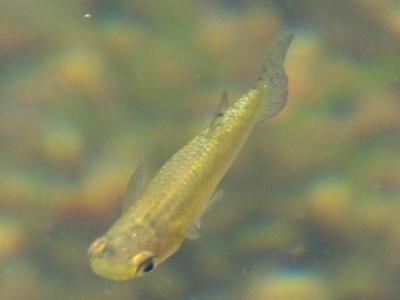Mosquitofish are found in much of North America. Two species of mosquitofish are common on the continent; Western and Eastern. Both species are used as a biological control for mosquito larvae.
Mosquitofish can spawn from May through September with females carrying an average of 40 young. They are one of the few freshwater fish species that bear live young.
Young mosquitofish are able to swim around and feed much like the adults. These fish can increase their population very rapidly. Adults rarely live more than two years.
These small fish are very aggressive and have a reputation for being voracious eaters. They are best known for their abilty to consume mosquito larvae and pupae, which is how they get their name. They also feed on worms, small crustaceans, insects, snails, tadpoles, algae, fish eggs and young of other fish, including largemouth bass, common carp, and other species.
Eastern Mosquitofish (Gambusia holbrooki)

The eastern mosquitofish reaches lengths of around 1.5 inches long. Adults are light olive-brown on top, with silvery sides and a yellowish belly. They usually have rows of black spots on their dorsal and caudal (tail) fins. Another identifying feature is a black “tear drop” under the eye of adult eastern mosquitofish.
The Eastern mosquitofish is native to Atlantic and Gulf Slope drainages as far west as southern Alabama. The species is found in ponds, lakes, marshes, and slow-moving streams. They prefer muddy bottoms, shallow water, and aquatic plants.
Western Mosquitofish (Gambusia affinis)
The western mosquitofish is identified by its short body, upturned mouth, and a flattened head. The dorsal fin is located well back toward the tail with the front of the fin starting behind the front of the anal fin. The mouth is upturned and there are no bars or bands on the sides. Adult western mosquitofish are grayish-tan in color. Some individuals have small dark spots on their fins, back or sides.
Western mosquitofish prefer ponds or very slow flowing streams with clear water and abundant aquatic vegetation.